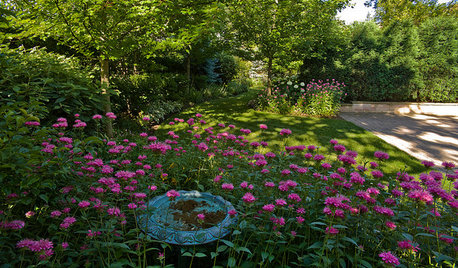Does seville grass thatch heavily and kill itself?
guy777
9 years ago
Related Stories

LANDSCAPE DESIGNIs It Time to Consider Fake Grass?
With more realistic-looking options than ever, synthetic turf can be a boon. Find the benefits and an installation how-to here
Full Story
GRASSESHow to Rock a Lawn
Weekend Project: The key to healthy grass begins with the soil. If turf works for you, here’s how to fix it and keep it looking its best
Full Story
GARDENING GUIDES10 Tips to Start a Garden — Can-Do Ideas for Beginners
Green up your landscape even if you're short on time, money and knowledge, with these manageable steps for first-time gardeners
Full Story
GARDENING FOR BUTTERFLIESGardening for the Bees, and Why It’s a Good Thing
When you discover how hard bees work for our food supply, you may never garden without them in mind again
Full Story
LANDSCAPE DESIGNExuberant Self-Seeders for Gorgeous, Easy-Care Gardens
Keep weeds down, color high and maintenance low with beautful plants that sow themselves
Full Story
GARDENING GUIDES10 Deer-Resistant Native Flowers to Plant This Fall
Learn about natives that embrace some kinds of wildlife but resist grazing deer
Full Story
GARDENING GUIDESGarden Myths to Debunk as You Dig This Fall and Rest Over Winter
Termites hate wood mulch, don’t amend soil for trees, avoid gravel in planters — and more nuggets of garden wisdom
Full Story
LANDSCAPE DESIGNCalifornia Says Goodbye to the Sprawling Ornamental Lawn
New state rules will effectively limit turfgrass to 25 percent of the landscape in most new and renovated yards
Full Story
GARDENING GUIDESHow to Switch to an Organic Landscape Plan
Ditch the chemicals for a naturally beautiful lawn and garden, using living fertilizers and other nontoxic treatments
Full Story
GARDENING AND LANDSCAPINGGrow a Lush Privacy Screen
No need to wait forever for patio privacy the green way. These 10 ideas will get your screening up and running in no time
Full Story







agrocoders
dchall_san_antonio
Related Professionals
Finneytown Landscape Architects & Landscape Designers · Elgin Landscape Contractors · Avocado Heights Landscape Contractors · Burlington Landscape Contractors · Clark Landscape Contractors · Danvers Landscape Contractors · Dickinson Landscape Contractors · East Chicago Landscape Contractors · Lynchburg Landscape Contractors · Oxnard Landscape Contractors · Plainview Landscape Contractors · Plymouth Landscape Contractors · Ringwood Landscape Contractors · Greenfield Landscape Contractors · Stafford Swimming Pool Buildersguy777Original Author
dchall_san_antonio
guy777Original Author
guy777Original Author
dchall_san_antonio
agrocoders
dchall_san_antonio
guy777Original Author
dchall_san_antonio
guy777Original Author
guy777Original Author
guy777Original Author
weed_cutter
weed_cutter
guy777Original Author
dchall_san_antonio
weed_cutter
guy777Original Author
weed_cutter
guy777Original Author
guy777Original Author
dchall_san_antonio
guy777Original Author
weed_cutter
dchall_san_antonio
guy777Original Author
dchall_san_antonio
guy777Original Author
danielj_2009
dchall_san_antonio
guy777Original Author
dchall_san_antonio
danielj_2009
guy777Original Author
guy777Original Author
PKponder TX Z7B
guy777Original Author
PKponder TX Z7B
dchall_san_antonio
PKponder TX Z7B
guy777Original Author
guy777Original Author
dchall_san_antonio
guy777Original Author
guy777Original Author
danielj_2009
guy777Original Author
guy777Original Author